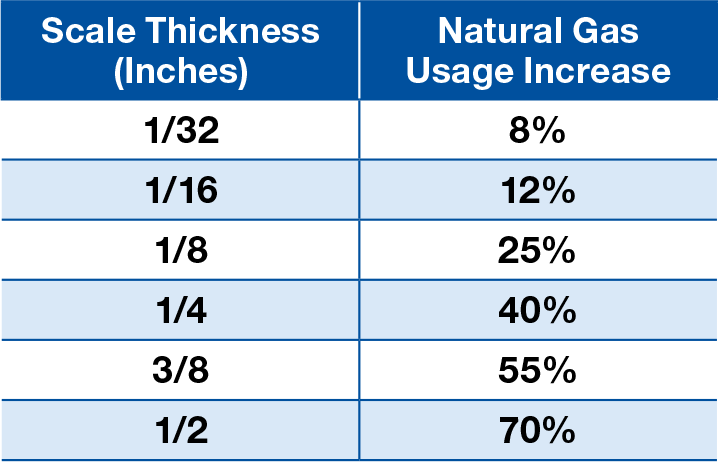Realize real cost savings with Chemetall descaling products and solutions
Nozzle and pipe descaling
Maximize your spray efficiency
- Scale, soils, and particles deposit on the inside of the nozzle and restrict flow uniformity from the nozzle.
- These photos compare the spray pattern of a clogged nozzle versus an unclogged nozzle.
- Cross section of a pipe before and after descaling.
Heat exchanger descaling
Maximize your heat exchanger efficiency
- Scale forms when water salts in the solution settle and plate on the outside of the heater tube.
- The scale builds and becomes thicker over time and acts as an insulator, preventing the heat from the heater tube from reaching the solution.
- Scale build up leads to a higher usage of natural gas.
How scale can affect cost efficiency
A washer with an 1/8 of an inch of scale on the heater tube could cost an additional $50,000 per year for gas.
Effective descaling may save up to $12,500 per year for gas.
Potential percentage of increase in natural gas usage due to scale.

Click table to view large.
Innovative products and solutions from Chemetall
Gardoclean R1700F
- Liquid caustic-based product
- Used for steel or stainless steel
- Temperatures 120 to 160°F
- Typically used at 5 to 20% by volume
- Safer and less fuming then muriatic (hydrochloric) acid-based descalers
- Use Gardobond Additive H 7230 to neutralize
Gardacid P4309
Liquid inhibited sulfuric acid product
Used for stainless steel
Inhibited to minimize attack on mild steel
Typically used at 3 to 5% by volume
Temperatures up to 140°F
Use Gardobond Additive H 7212 to neutralize
Gardobond Additive H7002/2
Peroxide-based
Used for stainless steel for biological removal
Typically used at 3 to 5 % by volume
Breaks down to water and oxygen
Gardobond Additive H7140/1
Liquid nitric acid product
Used only for stainless steel
Available in polyethylene containers
Typically used at 5 to 50% by volume
Temperatures up to 120°F
Safer and less fuming than commodity nitric or
muriatic (hydrochloric) acid-based descalers
Use Gardobond Additive H 7212 to neutralize
Our experts are here to help!
Download a PDF of this case study click here.